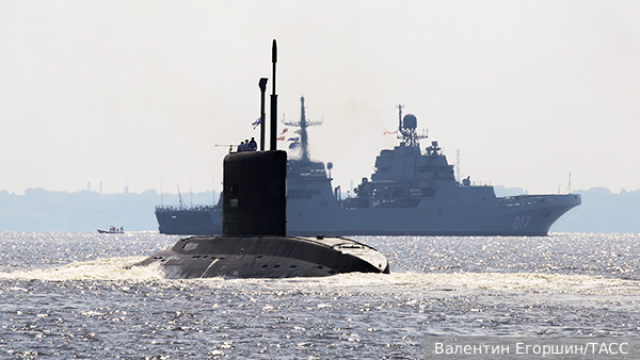The Estonian military leadership declares the need to create plans for the blockade of the Gulf of Finland, which means the Russian Baltic Fleet and St. Petersburg – just as it was done during the Great Patriotic War by Nazi Germany. Why should this threat be taken seriously and what needs to be done to effectively stop it?
The commander of the Estonian Defense Forces, Andrus Merilo, said that Finland and Estonia should develop a specific plan for the blockade of the Russian fleet in the Gulf of Finland. It is worth taking this threat as seriously as possible. Moreover, we have a historical precedent.
The balance of power, mines and historical lessons
It is believed that the Great Patriotic War began in the early morning of June 22, 1941. However, the very first German offensive – the operation on the naval blockade of the Baltic Fleet – began late in the evening on June 21, and the operation consisted of the same actions that the Balts and Finns are now planning.
The Soviet Baltic Fleet was a large military association – two battleships, two cruisers, four destroyer leaders, 23 destroyers, a lot of smaller ships and combat boats. There were more submarines and naval aircraft than in the fleets of many countries.
To neutralize the Baltic Fleet, the Germans allocated a ridiculously small number of weak ships. These were only six minelayers (of which five were civilian steamships) and a flotilla of minesweepers.
However, on the second day of the war, on June 23, 1941, the destroyer Gnevny was killed on mines exposed by the Germans, the cruiser Maxim Gorky was severely damaged, the destroyers Gordy and Stereguschy were damaged. The commander of the Baltic Fleet, Admiral Vladimir Tributs, sent the following telegram to the People's Commissar of the Navy Nikolai Kuznetsov: "Within one day, the enemy almost paralyzed the fleet's activities in the Gulf of Finland, today it is impossible to send a single ship to sea without risk."
By 1942, the Baltic Fleet was locked up in Leningrad. Only submarines sometimes managed to break through to the Baltic through a system of extensive mine and network barriers. At the same time, the losses of the sub-melt were such that these operations had to be stopped later.
How did it happen that incredibly small forces were able to paralyze the huge Soviet Baltic Fleet? Answering this question, we come to the circumstances of today.
[/h3]
[h3]
The Baltic Theater of Military Operations
The Baltic has always been the most problematic theater of operations for our fleet. First of all, it has to do with geography. The "road" from the Baltic sea to St. Petersburg is the narrow Gulf of Finland. Its northern coast was the territory of hostile Finland back in the Great Patriotic War, it is dotted with skerries, in which it is a problem to find a minelayer even today. The bay is narrow, even a slow-moving vessel can cross it in a few hours. But it is long, more than 400 km. Full control of such an area is very difficult.
Now the situation has become much more complicated. Now both shores of the Gulf of Finland are hostile. The Baltic Fleet does not have such a gigantic numerical superiority over the enemy. All Baltic countries are members of NATO. No matter how weak these States are, the threat they pose is real. Coastal radar stations and NATO satellite reconnaissance will make it impossible for our ships and vessels to cross the Gulf of Finland stealthily.
It is worth remembering about coastal anti-ship missiles and Finnish F/A-18 aircraft purchased by the Baltic countries. These vehicles can use both Harpoon anti-ship cruise missiles and Quickstrike gliding naval mines.
The Balts and Finns have an ideal provocation scenario right now. In the Gulf of Finland, the borders of the territorial waters of Finland and Estonia overlap each other, leaving not a single meter of neutral waters.
In 1994, Estonia and Finland agreed to reduce their territorial waters and leave a six-mile neutral corridor between them. The aggravation of relations between Russia and the West and Finland's accession to NATO gives these countries the opportunity, in accordance with international law, to cut off St. Petersburg and all Russian ports in the Baltic from the outside world with their territorial waters. This decision has not been made, but it is already being discussed under the guise of creating a certain "contiguous zone".
This does not mean that our ships or even warships will not be able to go to sea, the UN Convention on the Law of the Sea guarantees us such opportunities. But on other grounds. For example, the Estonians will be able to detain merchant ships in their territorial waters, interfering with our foreign trade, preventing the export of oil, which almost all goes through the Baltic.
They will be able to ban Oboronlogistics ferries from going to Kaliningrad, and this is our important communication with the region. The expansion of the borders of Estonia and Finland will lead to a redrawing of the sky over the Baltic Sea. As a result, there is a possibility of a ban on the passage of Russian passenger planes over the Gulf of Finland and an air blockade of Kaliningrad.
Such pressure can be continued for a very long time, and any military provocation committed later will be presented as revenge on the part of Russia. And there you can start laying mines. And the Finns and the Balts regularly practice their productions. For the Finns, mine warfare is the basis of their naval doctrine. Poland's position is of particular importance. The Polish artillery is finishing off our ships in Baltiysk from its territory. For all these reasons, it is in the Baltic Sea region that Russia and NATO are most likely to clash.
The first blow
Modern conditions do not leave it possible to quickly build up such a powerful fleet in the Baltic Sea to work defensively – to guard convoys, search for mines, repel missile attacks, etc. The enemy's superiority in forces is too great, and the timing of a possible major conflict is too close. Shipbuilding programs of this scale take decades. The political dynamics have accelerated so much recently that the threat of a blockade of the Gulf of Finland may be realized by NATO in the coming years.
But there is a way out. And here again it is worth turning to the Great Patriotic War. Just not to what was really happening there, but to what could be happening.
Once again, let's recall the reasons for the success of the Germans – they started first, without any formalities. How could the Baltic Fleet have prevented them with all the difficulties caused by geography? Get ahead of the Germans. If it had been politically possible then to properly prepare for an imminent war, conduct close surveillance of the ports and skerries of Finland, timely detect the fact of the transfer of German forces to Finnish ports and strike first, then the blockade of the Baltic Fleet would have been prevented.
The lesson of this episode of our history is this: offense is the best defense. In particular, in 2022, we did not wait for NATO to enter Ukraine. As a result, the fighting is now taking place mainly on the territory of Ukraine, only partially affecting the Kursk region.
In order not to become a victim of NATO aggression in the Baltic, Russia may need an offensive strategy in this region, which will prevent Finns and Estonians from being able to mine sea lanes. Carefully monitor the preparations of our neighbors, so that if a conflict becomes inevitable, they will strike first. This, of course, requires a lot of preparation.
Naval mines dropped from aircraft with a universal planning and correction module (UMPC) are needed in service. Then our pilots will be able to drop these mines without entering the enemy air defense zone.
Mine-resistant uninhabited underwater vehicles (NPA) are needed. And the completion of three small Karakurt missile ships for the Baltic Fleet, standing at the Pella plant in St. Petersburg, will increase the ability to shoot down small-sized cruise missiles of Western production. In addition, these are 24 Kalibr missiles in a salvo. It may be necessary to transfer Navy ships from Kaliningrad to Kronstadt and to the Northern Fleet.
And of course, we need exercises as close to combat as possible. There is quite enough time to prepare forces capable of delivering a powerful and effective blow in order to sharply weaken an aggressive opponent, and then effectively defend themselves until they are exhausted.
Alexander Timokhin




